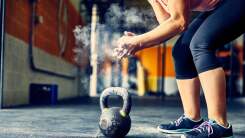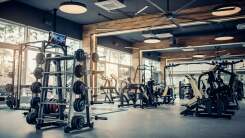Gym Chalk Is Your Secret Weapon for Lifting More Weight

If you’ve ever seen someone chalk up before a big deadlift, maybe clapping a big cloud of the stuff into the air, you might wonder if it’s actually even doing anything. But chalk is a useful tool if you’re lifting heavy, so let’s dive in and talk about when you need it and how to use it.
What is lifting chalk, anyway?
Gym chalk is made of the mineral magnesium carbonate. It’s used by gymnasts, climbers, and weightlifters to absorb sweat on their hands and increase the friction between their hands and whatever they’re holding (the barbell, the climbing holds, etc).
There are other types of chalk in the world, but they’re not interchangeable. Your standard blackboard chalk is calcium carbonate, and sidewalk chalk is usually calcium sulfate. If you want to buy chalk for your home gym or to carry in your gym bag, make sure you’re getting gym chalk.
How chalk helps you lift more weight
The main reason people use chalk in the gym is because having a better grip on the bar helps you lift more. You’ll see chalk used most often on pulling exercises like deadlifts, or lifts that include a pull, such as snatches and cleans.
Chalk adds some grit between your sweaty hand and the bar you’re holding, and that’s its magic—the sweat-and-chalk combo provides a much more secure grip than if you were holding that same bar without the chalk. As a result:
-
Chalk makes your hands feel less sweaty.
-
Chalk helps to increase the amount of friction between your hand and the bar, making your grip more secure.
-
The improved grip can allow you to hold the bar or equipment without slipping, which can mean a reduced chance of losing your grip and failing the lift.
-
With that improved grip, the bar or equipment may be less likely to rub against your skin, thus reducing the chance of ripping a callus—but there’s a big caveat on this, which we’ll talk about in a moment.
To put it in simpler terms, chalking up your hands makes it easier to hold onto things. Sometimes the limiting factor in deadlifting more or doing more pullups isn’t your arm or leg strength—it’s your grip. With chalk, that becomes less of an issue.
When should you use chalk at the gym?
Chalk is useful, but that doesn’t mean you need it for every lift. I usually only visit the chalk bucket for my heaviest lifts, and there are plenty of workouts where I don’t use it at all. Here are some signs that it may be time to use chalk:
-
On a hot, sweaty day
-
When you’re nervous and your hands are sweating (I chalk up at competitions a lot more than I do in training!)
-
Heavy deadlifts, cleans, and snatches
-
High rep pull-ups
-
For any lift where your hands feel like they’re slipping
-
On any body part that’s slippery and shouldn’t be—for example, on your back and shoulders when you’re doing barbell squats.
There isn’t a hard and fast rule for when you “should” or “shouldn’t” use chalk—it’s a judgment call. You aren’t cheating by using chalk, and you don’t have to hit a certain level of strength to earn the privilege. If you aren’t sure, chalk up and see if it changes how secure your grip feels.
When chalk doesn’t help
Lifting chalk isn’t going to help in every situation. Here are some times when chalk is unlikely to solve your problems:
-
On very dry, cold days when your hands aren’t sweating at all. (Without sweat to absorb, the chalk doesn’t do much.)
-
For push exercises, like bench press. (Grip matters for pulling exercises, not really for pushing.)
-
When you want less friction, not more. (That stuff people put on their legs for deadlifts? That’s baby powder, to help the bar slide. Chalk would do the opposite.)
-
When your grip is failing, even with chalk. (You need straps.)
-
When you’re already using chalk, and you keep getting calluses and ripping them. (Chalk adds friction, which can make the situation worse.)
That last point can be a tricky one to figure out. If you’re doing lots of kettlebell swings or exercises like kipping toes-to-bar, your hands are probably rubbing against the bar or kettlebell a lot. Chalk can make your grip more secure, so that there’s less rubbing. But if you use chalk and there is still a lot of rubbing, you risk irritating your skin even more than you would without chalk.
Managing your calluses properly will help a lot (file or shave them down, rather than letting them get crusty and rip) but ultimately you’ll need to decide on a case-by-case basis whether chalk will help or hurt your situation. When in doubt, try it both ways and see.
Which kind of gym chalk is best?
Gym chalk comes in two common formats: liquid and dry. (There is also the ball of chalk dust, which climbers often keep in a pouch on their belt—but that’s less common in lifting gyms.)
Pros and cons of dry chalk
Dry chalk, or block chalk, comes in large blocks. Typically the gym staff will put blocks of chalk into a bowl or bucket in an accessible place on the gym floor, and you visit the bucket before you begin your lift. You can either rub the blocks onto your hands or dip your hands in the pile of dust that builds up at the bottom, or a combination of the two.
Block chalk is cheap to buy and convenient to share. Powerlifting, weightlifting, and CrossFit gyms all tend to have a communal bucket or three. You don’t need to bring your own; it will be provided. If you’ve ever watched a lifting event—say, weightlifting in the Olympics—this is why there’s a little bowl that the athletes stick their hands in before they approach the platform.
We’ll talk about chalk bin etiquette in just a moment, but many gyms don’t like chalk buckets because they’re messy. Liquid chalk is a good alternative, since it tends to stay on your hands and not get on the floor or leave much residue on the equipment.
Pros and cons of liquid chalk
Liquid chalk is also made of magnesium carbonate, but in this case it’s ground ultra-fine and mixed with alcohol. You’ll typically carry this in a bottle and squeeze a dollop onto your hands a minute before you lift. After you rub it on your hands, the alcohol dries, leaving a thin layer of chalk behind. Some people swear that liquid chalk gives you an even more secure grip than the dry stuff.
If your gym doesn’t provide a chalk bucket, liquid chalk is a good way to bring your own personal supply. It’s also less messy; I’ve heard of several gyms that had a “no chalk” policy but looked the other way when lifters brought their own liquid chalk and used it discreetly.
As for downsides, I don’t personally like the feel of liquid chalk, and I don’t enjoy waiting around for 30 seconds for it to dry on my hands. Then again, I also don’t love the feeling of reaching into a chalk bucket and getting chalk dust under my fingernails. Ultimately, the type of chalk to use is your preference.
Basic chalk etiquette at the gym
One last thing we need to discuss: how to use chalk without being an asshole about it. You only need the chalk on your hands—not on the floor, and not suspended in the air. Keep your hands inside (or at least over) the chalk bowl or bucket when you’re applying it, and when you’re done, rub your hands together so that any loose grains can fall back into the bucket. That way, you won’t get chalk all over the gym; it only really needs to touch your hands (or whatever body part you’re chalking up) and the bar or weight you’re holding.
And speaking of that bar: You’ll want to clean the chalk off it afterward. If a gym has a chalk bucket, it should also have a little brush somewhere (often looking like an oversized, wire-bristled toothbrush). When you’re done with your workout, use the brush to clean the chalk out of the knurling.



